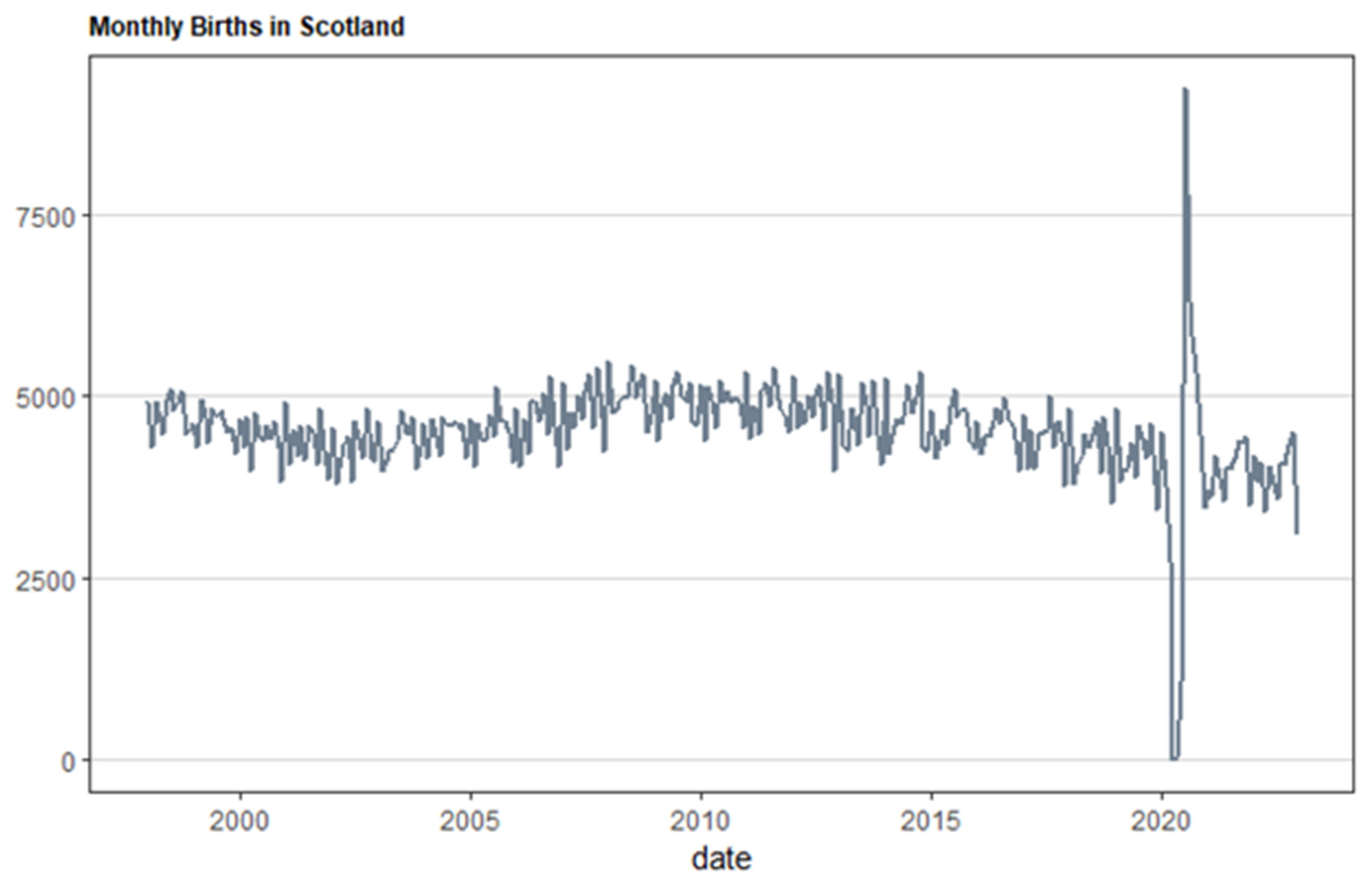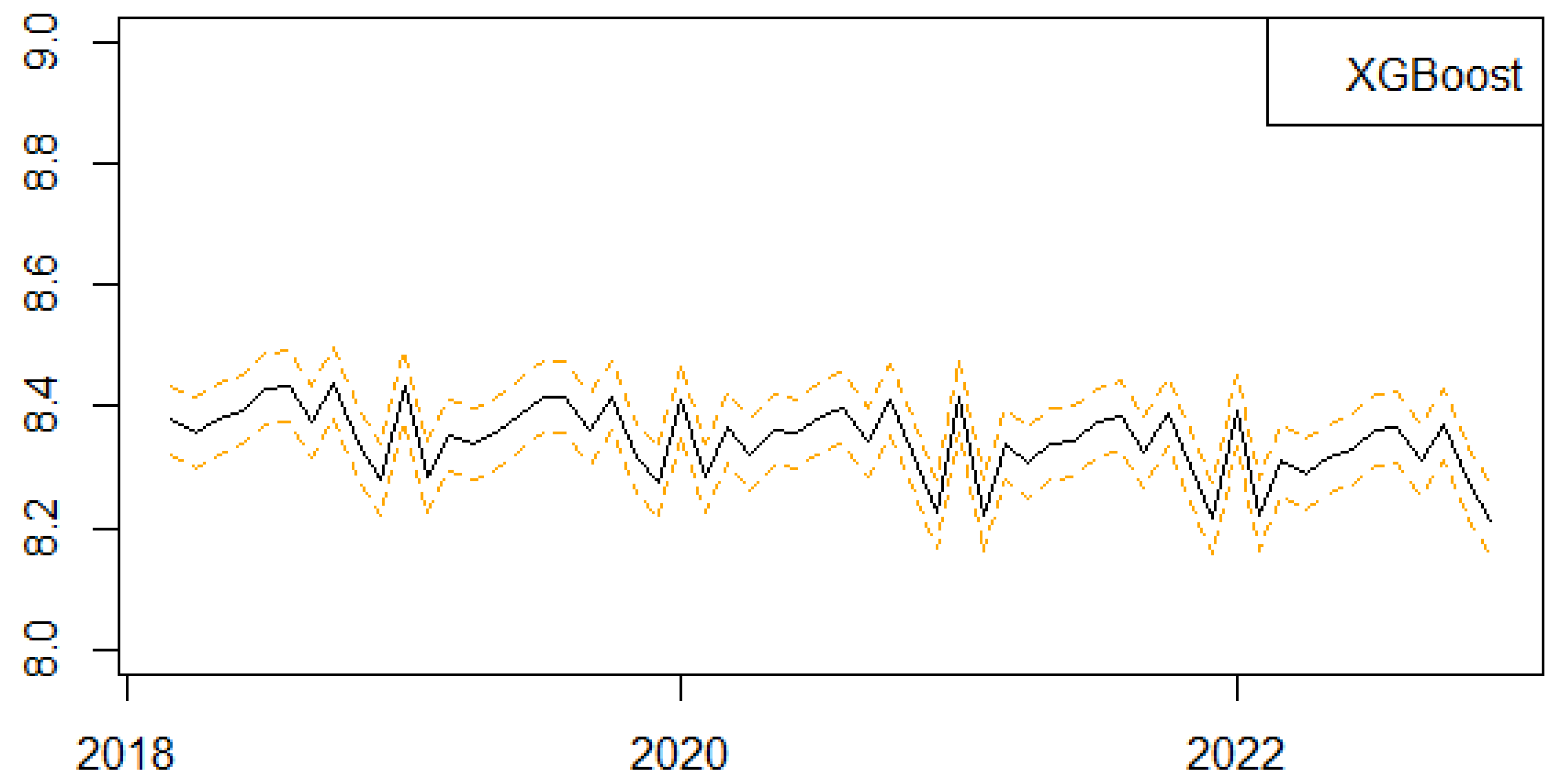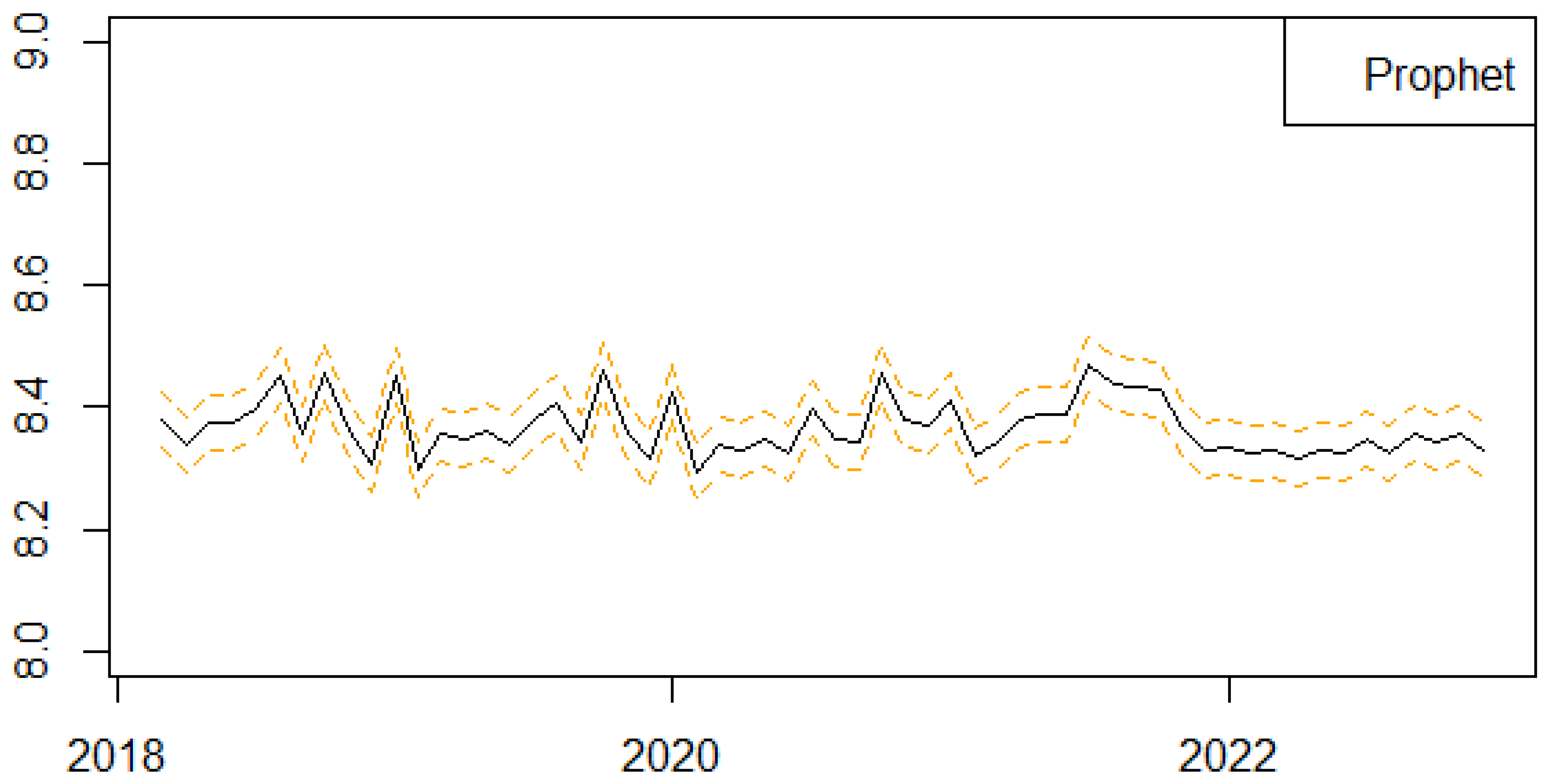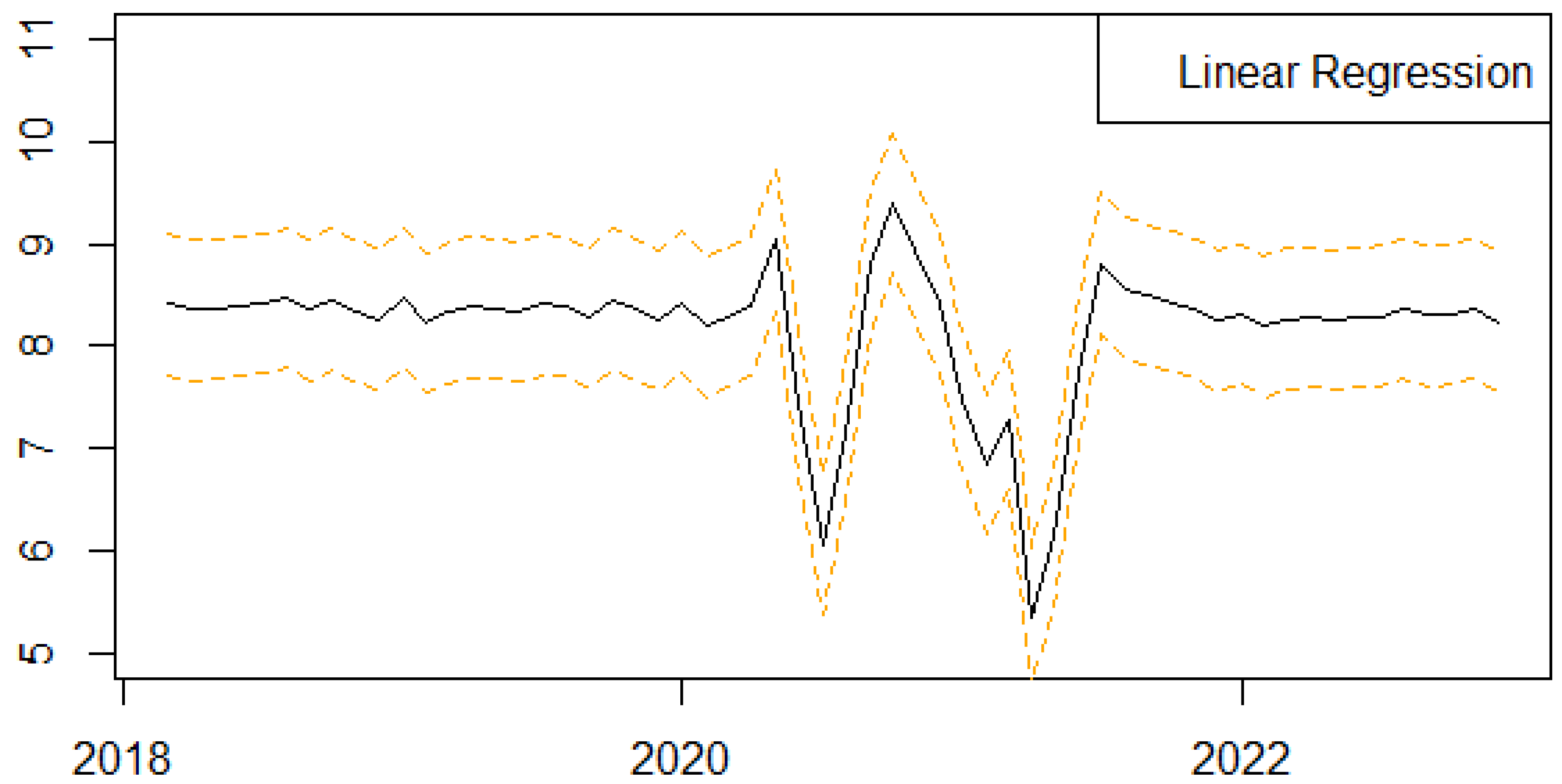Predicting Future Birth Rates with the Use of an Adaptive Machine Learning Algorithm: A Forecasting Experiment for Scotland
Abstract
1. Introduction
2. Methodology
2.1. Machine Learning Models
Facebook Prophet
2.2. Random Forest
2.3. Extra Trees
2.4. Extreme Gradient Boosting (XGBoost)
2.5. Evaluation Metrics
3. Data
4. Results
5. Concluding Remarks
Author Contributions
Funding
Institutional Review Board Statement
Informed Consent Statement
Data Availability Statement
Conflicts of Interest
References
- Balbo, N.; Billari, F.C.; Mills, M. Fertility in Advanced Societies: A Review of Research. Eur. J. Popul. 2013, 29, 1–38. [Google Scholar] [CrossRef]
- Tzitiridou-Chatzopoulou, M.; Orovou, E.; Zournatzidou, G. Digital Training for Nurses and Midwives to Improve Treatment for Women with Postpartum Depression and Protect Neonates: A Dynamic Bibliometric Review Analysis. Healthcare 2024, 12, 1015. [Google Scholar] [CrossRef]
- Russell, A.C.; Santucci, N.R.; Tzitiridou-Chatzopoulou, M.; Kountouras, J.; Zournatzidou, G. The Potential Impact of the Gut Microbiota on Neonatal Brain Development and Adverse Health Outcomes. Children 2024, 11, 552. [Google Scholar] [CrossRef]
- Hilton, J.; Dodd, E.; Forster, J.J.; Smith, P.W.F.; Bijak, J. Forecasting Fertility with Parametric Mixture Models. arXiv 2019, arXiv:1909.09545, 1–26. [Google Scholar]
- De Beer, J. A time series model for cohort data. J. Am. Stat. Assoc. 1985, 80, 525–530. [Google Scholar] [CrossRef]
- Thompson, P.A.; Bell, W.R.; Long, J.F.; Miller, R.B. Multivariate Time Series Projections of Parameterized Age-Specific Fertility Rates. J. Am. Stat. Assoc. 1989, 84, 689–699. [Google Scholar] [CrossRef]
- Congdon, P. Graduation of Fertility Schedules: An Analysis of Fertility Patterns in London in the 1980s and an Application to Fertility Forecasts. Reg. Stud. 1990, 24, 311–326. [Google Scholar] [CrossRef]
- Bell, W. Applying Time Series Models in Forcasting Age-Specific Fertility Rates. Statistical Research Division Report Series-US. 1988. Available online: https://www.census.gov/library/working-papers/1988/adrm/rr88-19.html (accessed on 8 June 2024).
- Hozik, J.E.; Bell, W.R. Forecasting Age-Specific Fertility Using Principal Components. American Statistical Association, Social Statistics Section, Statistica; (CENSUS/SRD/RR-87/19). 1987; pp. 1–14. Available online: https://www.census.gov/library/working-papers/1987/adrm/rr87-19.html (accessed on 8 June 2024).
- Lee, R.D. Modeling and forecasting the time series of US fertility: Age distribution, range, and ultimate level. Int. J. Forecast. 1993, 9, 187–202. [Google Scholar] [CrossRef]
- Hyndman, R.J.; Shahid, U. Robust forecasting of mortality and fertility rates: A functional data approach. Comput. Stat. Data Anal. 2007, 51, 4942–4956. [Google Scholar] [CrossRef]
- Wiśniowski, A.; Smith, P.W.F.; Bijak, J.; Raymer, J.; Forster, J.J. Bayesian Population Forecasting: Extending the Lee-Carter Method. Demography 2015, 52, 1035–1059. [Google Scholar] [CrossRef]
- Myrskylä, M.; Goldstein, J.R.; Cheng, Y.-H.A. New Cohort Fertility Forecasts for the Developed World: Rises, Falls, and Reversals. Popul. Dev. Rev. 2013, 39, 31–56. [Google Scholar] [CrossRef]
- Evans, M.D.R. American Fertility Patterns: A Comparison of White and Nonwhite Cohorts Born 1903-56. Popul. Dev. Rev. 1986, 12, 269–293. [Google Scholar] [CrossRef]
- Li, N.; Zheng, W. Forecasting cohort incomplete fertility: A method and an application. Popul. Stud. 2003, 57, 303–320. [Google Scholar] [CrossRef]
- Peristera, P.; Anastasia, K. Modeling fertility in modern populations. Demogr. Res. 2007, 16, 141–194. [Google Scholar] [CrossRef]
- Ševčíková, H.; Nan, L.; Vladimíra, K.; Patrick, G.; Adrian, E.R. Age-Specific Mortality and Fertility Rates for Probabilistic Population Projections. Dyn. Demogr. Anal. 2015, 39, 285–310. [Google Scholar] [CrossRef]
- Schmertmann, C.; Zagheni, E.; Goldstein, J.R.; Myrskylä, M. Bayesian Forecasting of Cohort Fertility. J. Am. Stat. Assoc. 2014, 109, 500–513. [Google Scholar] [CrossRef]
- Alkema, L.; Raftery, A.E.; Gerland, P.; Clark, S.J.; Pelletier, F.; Buettner, T.; Heilig, G.K. Probabilistic projections of the total fertility rate for all countries. Demography 2011, 48, 815–839. [Google Scholar] [CrossRef] [PubMed]
- De Iaco, S.; Sabrina, M. A dynamic model for age-specific fertility rates in Italy. Spat. Stat. 2016, 17, 105–120. [Google Scholar] [CrossRef]
- Mazzuco, S.; Bruno, S. Fitting Age-Specific Fertility Rates By a Skew-Symmetric Probability Density Function. J. R. Stat. Soc. Ser. A 2015, 178, 187–203. [Google Scholar] [CrossRef]
- Lutz, W.; Butz, W.P.; KC, S. World Population and Human Capital in the Twenty-First Century; Oxford University Press: Oxford, UK, 2014. [Google Scholar]
- Barro, R.; Lee, J.-W. Education Matters: Global Schooling Gains from the 19th to the 21st Century; Oxford University Press: Oxford, UK, 2015; Available online: https://econpapers.repec.org/RePEc:oxp:obooks:9780199379231 (accessed on 8 June 2024).
- Makridakis, S. Accuracy measures: Theoretical and practical concerns. Int. J. Forecast. 1993, 9, 527–529. [Google Scholar] [CrossRef]
- Majumder, S.; Kutum, R.; Khatua, D.; Sekh, A.A.; Kar, S.; Mukerji, M.; Prasher, B. On intelligent Prakriti assessment in Ayurveda: A comparative study. J. Intell. Fuzzy Syst. 2023, 45, 9827–9844. [Google Scholar] [CrossRef]
- Hyndman, R.J.; Koehler, A.B. Another look at measures of forecast accuracy. Int. J. Forecast. 2006, 22, 679–688. [Google Scholar] [CrossRef]
- Gardner, E.S. Exponential smoothing: The state of the art—Part II. Int. J. Forecast. 2006, 22, 637–666. [Google Scholar] [CrossRef]
- Hyndman, R.J.; Athanasopoulos, G. Forecasting: Principles and Practice; OTexts.Com/Fpp2; OTexts: Melbourne, Australia, 2018. [Google Scholar]
- De Livera, A.M.; Hyndman, R.J.; Snyder, R.D. Forecasting time series with complex seasonal patterns using exponential smoothing. J. Am. Stat. Assoc. 2011, 106, 1513–1527. [Google Scholar] [CrossRef]
- Taylor, S.J.; Letham, B. Forecasting at scale. Am. Stat. 2018, 72, 37–45. [Google Scholar] [CrossRef]
- Booth, H. Demographic Forecasting: 1980 to 2005 in review. Int. J. Forecast. 2006, 22, 547–581. [Google Scholar] [CrossRef]
- Bohk-Ewald, C.; Li, P.; Myrskylä, M. Forecast accuracy hardly improves with method complexity when completing cohort fertility. Proc. Natl. Acad. Sci. USA 2018, 115, 9187–9192. [Google Scholar] [CrossRef]
- Zournatzidou, G.; Mallidis, I.; Farazakis, D.; Floros, C. Enhancing Bitcoin Price Volatility Estimator Predictions: A Four-Step Methodological Approach Utilizing Elastic Net Regression. Mathematics 2024, 12, 1392. [Google Scholar] [CrossRef]
- Miller, R.B.; Hickman, J.C. Time Series Analysis and Forecasting. Transactions of Society of Actuaries 1973. 1973. Available online: https://www.soa.org/4934e6/globalassets/assets/library/research/transactions-of-society-of-actuaries/1973/january/tsa73v25pt1n7314.pdf (accessed on 8 June 2024).
- Cantor, D.; Land, K.C. Unemployment and crime rates in the post-World War II United States: A theoretical and empirical analysis. Am. Sociol. Rev. 1985, 50, 317–332. [Google Scholar] [CrossRef]
- Breiman, L. Random Forests. Mach. Learn. 2001, 45, 5–32. [Google Scholar] [CrossRef]
- Chen, T.; Guestrin, C. XGBoost: A scalable tree boosting system. In Proceedings of the ACM SIGKDD International Conference on Knowledge Discovery and Data Mining, San Francisco, CA, USA, 13–17 August 2016; pp. 785–794. [Google Scholar] [CrossRef]
- Goodwin, P.; Lawton, R. On the asymmetry of the symmetric MAPE. Int. J. Forecast. 1999, 15, 405–408. [Google Scholar] [CrossRef]
- Kuhn, M.; Wickham, H. Tidymodels: Easily Install and Load the ‘Tidymodels’ Packages. 2021. Available online: https://CRAN.R-project.org/package=tidymodels (accessed on 8 June 2024).
- Grolemund, G.; Wickham, H. lubridate: Make Dealing with Dates a Little Easier. 2021. Available online: https://CRAN.R-project.org/package=lubridate (accessed on 8 June 2024).
- Dancho, M. Modeltime: The Tidymodels Extension for Time Series Modeling (Version 1.2.8). 2023. Available online: https://CRAN.R-project.org/package=modeltime (accessed on 8 June 2024).
- Hansen, P.R.; Lunde, A.; Nason, J.M. The Model Confidence Set. Econometrica 2011, 79, 453–497. [Google Scholar] [CrossRef]








| Mean | 8.381 |
|---|---|
| Median | 8.427 |
| Maximum | 9.131 |
| Minimum | 2.944 |
| Standard Deviation | 0.429 |
| Skewness | −10.526 |
| Kurtosis | 124.054 |
| Jarque–Bera | 188,717 *** |
| Jarque–Bera probability | [0.000] |
| Model | MAE | RMSE | SMAPE |
|---|---|---|---|
| ARIMA | 0.44 | 0.52 | 0.72 |
| Prophet | 0.37 | 0.46 * | 0.54 |
| Random Forest | 0.34 | 0.44 * | 0.57 |
| Extreme Gradient Boosting | 0.32 | 0.41 * | 0.54 |
| Linear Regression | 0.45 | 0.62 | 0.67 |
Disclaimer/Publisher’s Note: The statements, opinions and data contained in all publications are solely those of the individual author(s) and contributor(s) and not of MDPI and/or the editor(s). MDPI and/or the editor(s) disclaim responsibility for any injury to people or property resulting from any ideas, methods, instructions or products referred to in the content. |
© 2024 by the authors. Licensee MDPI, Basel, Switzerland. This article is an open access article distributed under the terms and conditions of the Creative Commons Attribution (CC BY) license (https://creativecommons.org/licenses/by/4.0/).
Share and Cite
Tzitiridou-Chatzopoulou, M.; Zournatzidou, G.; Kourakos, M. Predicting Future Birth Rates with the Use of an Adaptive Machine Learning Algorithm: A Forecasting Experiment for Scotland. Int. J. Environ. Res. Public Health 2024, 21, 841. https://doi.org/10.3390/ijerph21070841
Tzitiridou-Chatzopoulou M, Zournatzidou G, Kourakos M. Predicting Future Birth Rates with the Use of an Adaptive Machine Learning Algorithm: A Forecasting Experiment for Scotland. International Journal of Environmental Research and Public Health. 2024; 21(7):841. https://doi.org/10.3390/ijerph21070841
Chicago/Turabian StyleTzitiridou-Chatzopoulou, Maria, Georgia Zournatzidou, and Michael Kourakos. 2024. "Predicting Future Birth Rates with the Use of an Adaptive Machine Learning Algorithm: A Forecasting Experiment for Scotland" International Journal of Environmental Research and Public Health 21, no. 7: 841. https://doi.org/10.3390/ijerph21070841
APA StyleTzitiridou-Chatzopoulou, M., Zournatzidou, G., & Kourakos, M. (2024). Predicting Future Birth Rates with the Use of an Adaptive Machine Learning Algorithm: A Forecasting Experiment for Scotland. International Journal of Environmental Research and Public Health, 21(7), 841. https://doi.org/10.3390/ijerph21070841






